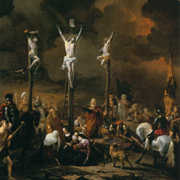Telemann’s Passion to a text by Brockes is distinguished by its powerful emotions and their skilful realisation using rich compositional means. A rewarding alternative for Passiontide concerts.
Telemann’s Passion oratorio after Brockes was first performed on 2 April 1716 in Frankfurt in an unusual concert in the Barfüßerkirche. According to Telemann, the instrumentalists and singers engaged were amongst the “most famous”. The audience included the Landgrave of Hesse, the employer of most of the musicians, as well as other “royal persons”. There was a keen interest amongst the public in advance of the performance. The unusual libretto by Barthold Heinrich Brockes (1680–1747) had been published in 1712 and had been previously set by Reinhard Keiser. Brockes paraphrased the Passion story in an artistic and highly expressive poetic language. A narrator called the “Evangelist” allows both the biblical characters and allegorical figures (“gläubige Seelen” [‘Christian Faithful’], “Tochter Zion”) to express themselves. Cantatas marked “Soliloquium” for individual protagonists are integrated into the narrative. In terms of content, the poet follows the interpretative traditions of his time, also reflected in the choice of the four verses of the arias. Telemann acclaimed the text as a “masterwork” of the “famous Hr. Lic. Brockes”. He set the text to music in an appropriate style, aimed at arousing strong emotions, with satisfying “extreme, unusual, graphic compositional means” (Wolfgang Hirschmann 2005). There is a wide range of keys, subtly differentiated declamation and a resulting sensitive and subtle rhythmic and melodic fashioning, and varied instrumentation.
An almost expressionistic, extended Sinfonia sets the mood for the action. In the arias, Telemann interprets not only the meaning of the words, but vividly translates them into music (“groaning”, “wailing”, “sighing”, “ray”, “bears paws”). For example, he portrays Petrus’s repentance by using chromatic turns and an angular declamation. This is also characteristic of the trio “O Donnerwort”, commenting on and contrasting with Jesus’s comparatively succinct words “Es ist vollbracht”. When Telemann gives meticulous expression to the rhetorically conflicting phraseology of the text, he is always bearing the overall concept in mind.
However broad and subtly differentiated the range of expression in the poetry may be, the music is equally sophisticated, demanding the highest virtuosity. Telemann attached great importance to his work and relished to its success. The extensive source material is also evidence of this success. It is evident that in the course of the performance history of the work, there were even light retouches. Some of the surviving copies reveal that the original recitative-style Turbae interjections – concise, declamatory and exciting, and performed by the individual protagonists only – were replaced by short, melodic tutti movements. The new edition takes this discovery into account, so that the interpreter can choose between the version of the premiere in 1716 with the recitative Turbae interjections, and the tutti movements known until now; these were actually written later and are included in the Appendix.
Ute Poetzsch
(translation: Elizabeth Robinson)
(from [t]akte 1/2012)



